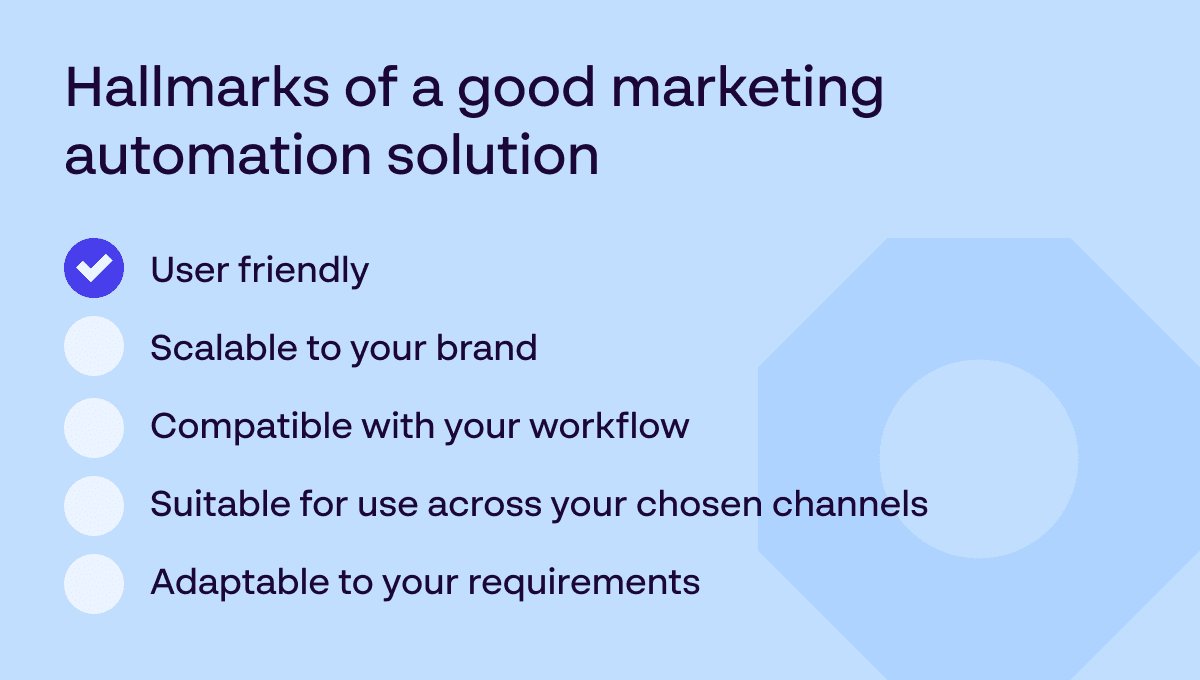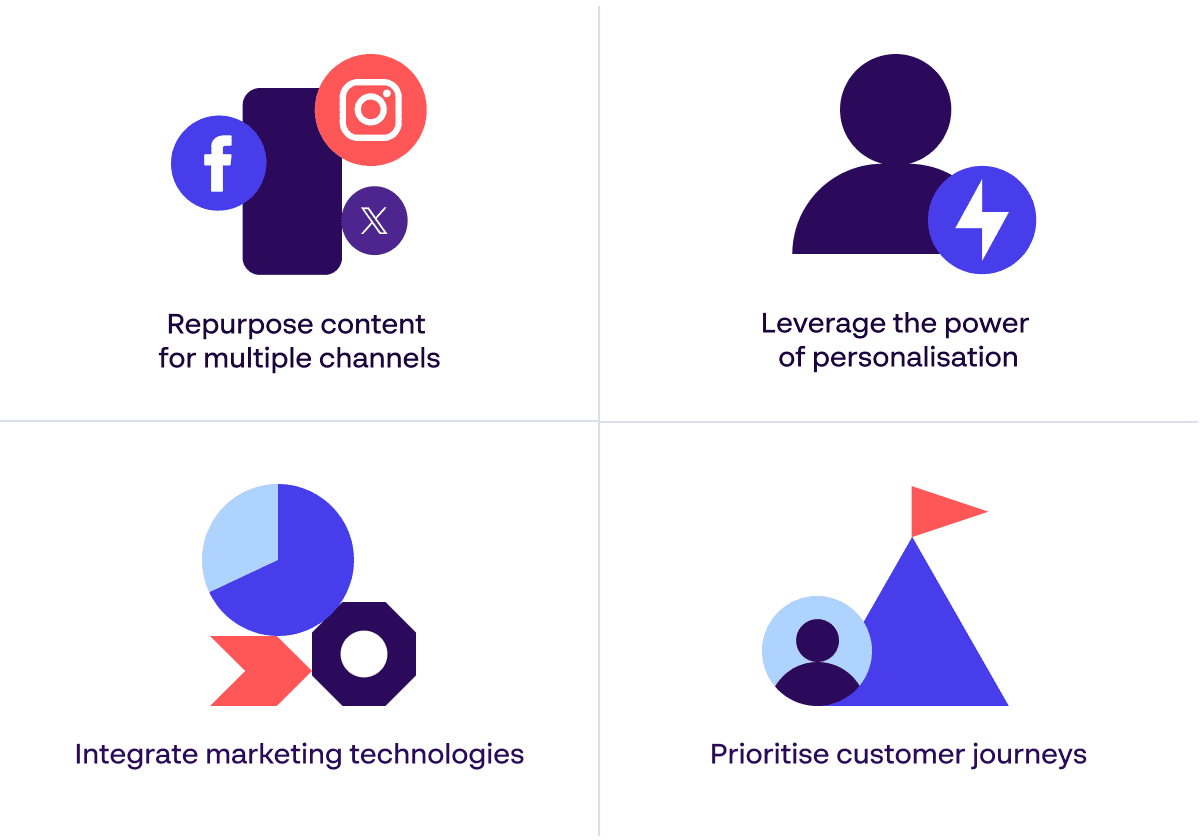The path between your brand and your customers was once far shorter and simpler. With fewer established marketing channels and a focus on local or national audiences, there were only so many routes marketers could take to connect with consumers.
With the rise of the internet and the ever-growing assortment of apps, social media channels and other platforms at our disposal, today’s digital landscape couldn’t be more different. It’s vast, global and highly connected – presenting opportunities and challenges in equal measure.

Today, multichannel marketing is the only way forward for ambitious, forward-thinking and customer-centric brands. To reach modern consumers, you must cast a wider net to engage them on their terms while keeping consistent at each of these touchpoints.
So, how do you truly deliver multichannel marketing? What are the benefits? What hurdles do you need to overcome? We outline all this and more below, so you know the secrets to executing high-performance, multichannel campaigns for your target audiences.
What is multichannel marketing?
Multichannel marketing is a way of reaching your customers by promoting your content on multiple channels simultaneously.
Whether that’s more traditional mediums like print and TV, digital platforms like social media and search engine advertising, or a combination of both, the ultimate goal of a multichannel strategy is to reach your audiences wherever they spend their time.
With many possibilities for consumers to discover and engage your brand – be it a web banner on their favourite news site, a compelling email marketing campaign, or eye-catching posters outside your high street outlets – a multichannel approach extends the potential touchpoints for your potential customers.
Multichannel marketing vs omnichannel marketing: What’s the difference?
Multichannel marketing is far from a new concept – its origins stretch back to the 1990s and early 2000s coinciding with the growing maturity of the internet and digital technologies. However, it has also been tied with omnichannel marketing, a term that started to gain prominence in the 2010s.
Although they share much of the same meaning, in that they both promote the use of multiple marketing channels to connect with consumers, there are key differences. The biggest of these is scope. A multichannel approach involves producing content for more than one platform; omnichannel means having a presence everywhere.
Another factor is the form these campaigns tend to take. In most cases, multichannel marketing is about fostering engagement, acting as a straight line from your brand to your customers. Omnichannel marketing, on the other hand, centres around creating a seamless brand experience.
Essentially, it’s possible to view omnichannel marketing as an evolution of multichannel marketing, where the fundamentals of the multichannel approach are supercharged into one flawless, integrated customer experience. But, in order to take that step, you must first be adept at multichannel marketing.

Why is multichannel marketing so important?
Did you know more than half of marketers create content for at least 3 or 4 channels? As the possibilities of the digital landscape become better understood and more accessible, more marketers are escaping the limitations of single-channel marketing strategies.
But just how powerful is multichannel marketing? Here are just some of the top-line benefits a broader approach can unlock for your brand.
Increases client lifetime value
As well as enabling you to reach a greater number of customers, sharing your marketing messages across multiple platforms empowers your brand to build a seamless customer experience wherever your audiences choose to spend their time.
This helps you create a base of loyal customers who trust your brand and are more likely to make repeat purchases. This improves customer lifetime value in the long term, giving you a sustainable platform for growth.

Boosts brand awareness
When your brand is present on the numerous channels and devices in your customer’s buying cycle, you are better able to reach and engage your prospects at the times and places that suit them and their natural behaviours.
This naturally breeds familiarity, which boosts people’s awareness of your content. With the right messaging across each touchpoint, a multichannel approach can be a powerful marketing tactic to keep your company’s products and services at the forefront of our audiences’ minds.
In fact, multichannel marketing is such an effective brand awareness tool that as many as 48% of promotional teams employ this strategy to get the word out.
Elevates customer understanding
As the old adage goes, knowledge is power. This is especially true in sales and marketing. It’s why the best salespeople listen more than they talk, and how the best marketing campaigns resonate with their target group.
And herein lies another key advantage of multichannel marketing: gathering customer insights. When people interact with your brand across multiple platforms – be that social media, email, websites or physical stores – you can build a clearer picture of your prospects’ behaviours, wants and pain points.
What kind of messaging resonates with them? What times are they most active? What are they interested in? All this insight becomes far more attainable and widespread when you move beyond a single-channel marketing strategy.
With solid data the backbone of any successful marketing campaign, this broader network of information can significantly elevate the performance of your promotions.

Expedites time to conversion
Did you know that it can take as many as 8 interactions with your brand before customers consider making a purchase?
If you’re limited to a single platform, it can become increasingly difficult and time-consuming to guide your potential prospects to the all-important conversion stage. But by leveraging several platforms at once, you can speed up the time involved in reaching this threshold.
Whether that means utilising direct mail in combination with social media advertising, or TV and radio together, building familiarity through multiple mediums is a proven way of empowering patrons to make a purchase.
Reduces overall cost per contact
As well as being associated with higher engagement and financial performance, taking a combined approach to your next marketing campaign can reduce your annual cost per contact by as much as 7.5%.
In a time when competition is becoming increasingly fierce and marketing budgets feel tighter than ever, being able to repurpose content and maximise the impact of your resources can be a huge boon for your campaigns’ performance and long-term return on investment.
Building your high-performance multichannel marketing campaign in 8 steps
Multichannel marketing has been at the forefront of countless growing brands. From Asana to First Direct, these are just some names that have unlocked the true potential of this medium to grow their reputation on a global stage.
But, like with any promotion, the right approach really matters. Success is never a given, especially when you consider the hurdles involved in rolling out a campaign of this scale.

If you’re keen to revolutionise your marketing performance, here are 8 steps to follow when building your own multichannel campaign.
1. Define clear objectives
The very first step in any productive multichannel marketing campaign involves establishing clear objectives.
Whether you’re looking to increase brand awareness and improve lead quality, or stimulate website traffic and build trust, defining what a successful multichannel marketing campaign looks like from the outset will inform every decision you make and the performance of your efforts from here on in.
For your goals to contribute to the wider success of your business and brand, good marketing objectives:
- Are informed by your business’s insights
- Align with your company’s mission and goals
- Are SMART – Specific, Measurable, Achievable, Relevant, and Time-sensitive
2. Understand your audiences
Next, you need to truly understand your target audiences. After all, if you don’t know your audiences inside and out, how will you select the best channels to reach them?
Ideally, you’ll want to establish strong buyer personas that give you and your team valuable insight into what your typical customer looks like, where and when they spend their free time, and what kind of messaging appeals to them.

Look into your in-house data to determine the attributes your most loyal consumers share. If not, conduct your own research by arranging interviews with people you think could fit your audience or analysing your competitors.
As we mentioned previously, knowledge is everything when it comes to the world of marketing. So, taking time at this early stage to define your customer journey, segment your audiences and build detailed customer profiles is critical.
3. Select the right channels
If you could show up everywhere, you would. But executing a fully-fledged omnichannel campaign isn’t a realistic goal for every business. To make the most of your existing resources, you must choose the most relevant, powerful platforms.
There is no right or wrong answer here. What avenues work for your brand is probably going to differ from other companies, even to those in your same industry.
By analysing the data you’ve gathered on your customers, as well as analytics acquired from your in-use channels and competitors, you can gain a clearer picture of where your revised focus should lie.
Whatever your initial data tells you, be sure to remain agile. Channels that seemed ideal from the outset may not reap the rewards you anticipated, and customer attitudes and behaviours are constantly shifting.
If your campaigns aren’t resonating on a particular platform or compromising your ability to manage your brand, be prepared and willing to pivot.
4. Create a multichannel marketing plan
With your objectives set, your audience defined and your channels locked down, you need to lay out your marketing plan and establish your roadmap for long-term success.
Although marketing plans will vary from campaign to campaign, a comprehensive proposal will typically include specific guidance on:

To inform each of these core areas, look over the data you have and be realistic about what you can achieve. Your marketing plan is your blueprint for success; by setting overly lofty goals, you risk going off-piste and falling below expectations.
5. Streamline content production
Now you have an idea of what needs to be achieved and how to do it, the next step in your multichannel marketing campaign is all about execution.
You can’t just speed into this process gung-ho. Rushed content doesn’t only reflect poorly on your brand, it can lead to inconsistencies that water down your brand equity, breed confusion, and shatter the trust your company has spent so long nurturing.
In order to give your marketers and frontline employees the power to produce content that is on-brand, high-quality and engaging, you should look into effective content creation software that incorporates simple, instant design templates.
Rather than requiring new collateral to be designed from scratch, the right templates give your users a strong starting point to base their content on for maximum consistency and efficiency. Design jobs that would have taken hours can instead be handled in minutes, even if the person making the assets has no design background.
With predefined colour palettes, logo positions, layouts and imagery, technology like this also significantly lowers the barrier to content production. That means anyone from your marketing department (or beyond) can build the collateral required to get campaigns off the ground, without needing to wait for spaces in your designers’ or agency’s schedules.
Your distributed teams can enjoy autonomy from your central marketing team, enabling you to greatly increase the volume and diversity of your content, without sacrificing quality or brand identity.
Additionally, solid content creation tools make it far easier to repurpose content for different platforms. A long video for your website can be easily carved into a series of mini-videos for social or photos in your brochures. Repurposing is a vital practice to master for multichannel promotions, allowing your teams to scale your content to greater heights.
Want to learn more about building a coherent, unified identity? Check out our ultimate guide to brand consistency.
6. Implement marketing automation software
Creating, planning and launching a multichannel campaign is a big job for even the most experienced marketing teams.
Good-quality marketing automation software can help manage the countless small tasks involved in running a clear campaign, avoiding common marketing pitfalls and presenting a consistent brand, such as:
- Personalising marketing emails
- Nurturing leads
- Scheduling social media posts
- Aggregating customer data
There is an abundance of marketing automation software out there vying for your attention. So, when selecting the right tools to support your ambitions, it’s important to understand the hallmarks of a trustworthy solution:

7. Coordinate campaigns effectively
Before launching your multichannel campaign, coordination between your channels and departments must be perfect.
Without supervision, it can be easy for targeted messages to find their way to the wrong segments, outdated collateral to go live on certain platforms, or your presence across regions to conflict.
Strong internal communication is the key to keeping everyone aligned and establishing a seamless customer experience across all platforms, but sometimes emails and video calls just don’t cut it.
Digital Asset Management (DAM) systems are a strong starting point. These solutions allow you to contain and categorise all of your content according to asset type, campaign, channel, location and more, so your teams can methodically coordinate each campaign.
Furthermore, robust campaign execution tools organise the flow of your collateral and enable seamless, global collaboration – again vital for consistent, successful multichannel campaigns.
8. Measure performance
To ensure you know how to assess the ongoing performance of your campaign when it goes live, establishing the metrics you’ll measure from the outset is a crucial final consideration.
This doesn’t mean examining absolutely everything. Instead, focus on the metrics that give you the greatest insight into your long-term objectives. Some of the most common indicators to track are:
- Social media engagement
- Return on investment
- Customer acquisition cost
As your multichannel marketing campaign matures, make it a habit to analyse the progress of your campaign. Ask yourself, are posts landing? Are sales being made? Is brand awareness improving? If not, be ready to adapt to achieve the best results possible.

Paving the way to a successful multichannel marketing campaign
In our increasingly complex landscape, multichannel marketing has become the new norm. Used by brands new and old to reach their customers and drive sales, this approach has proven its value in countless successful campaigns.
But mastering numerous channels at once is no easy feat. The right approach is vital to boost the bottom line of your business, elevate your brand’s awareness, speed up conversion and more.
By following the tips and techniques outlined in this article, you put your team on a firm foundation to overcome the challenges of a multi-faceted approach and build bridges with your customers wherever they wish to engage with your brand.

